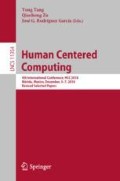Abstract
With the rapid development of human society, the scope and complexity of urban living space are increasing, and the demand for space position information is constantly improved by human activities. Especially in recent years, with the advent of the mobile Internet and the rapid popularization of smart phone terminals, the lifestyle and behavior habits of people are undergoing a huge change. Therefore, the positioning technology is also increasingly received by people. Among them, Wi-Fi fingerprint positioning is the most popular way. In this paper, we proposed Wi-Fi Attention Networks (WAN) for Wi-Fi fingerprint indoor positioning. In the WAN, a bidirectional LSTM is used to get a representation vector of Wi-Fi by summarizing the contextual information. Then, an attention mechanism is used to extract the Wi-Fi words which are important to the representation of Wi-Fi sequences and get a high-level representation vector. Finally, a fully connected network is used for classification. Experimental results demonstrate that WAN performs better than traditional machine learning methods on the publicly available dataset.
Access this chapter
Tax calculation will be finalised at checkout
Purchases are for personal use only
References
Sithole, G., Zlatanova, S.: Position, location, place and area: an indoor perspective. ISPRS Ann. Photogramm. Remote Sens. Spat. Inf. III-4, 89–96 (2016)
Xia, S., Liu, Y., Yuan, G., et al.: Indoor fingerprint positioning based on Wi-Fi: an overview. Int. J. Geo Inf. 6(5), 135 (2017)
Gentile, C., Alsindi, N., Raulefs, R., et al.: Geolocation Techniques: Principles and Applications. Springer, New York (2012). https://doi.org/10.1007/978-1-4614-1836-8
Bahl, P., Padmanabhan, V.N.: RADAR: an in-building RF-based user location and tracking system. Proc. IEEE INFOCOM 2000(2), 775–784 (2000)
Ni, L.M., Liu, Y., Lau, Y.C., et al.: LANDMARC: indoor location sensing using active RFID. Wirel. Netw. 10(6), 701–710 (2004)
Zhu, Y.J., Deng, Z.L., Liu, W.L., Xu, L.M., Fang, L.: Multi-classification algorithm for indoor positioning based on support vector machine. Comput. Sci. 39(4), 32–35 (2012)
Wang, X., Gao, L., Mao, S., et al.: DeepFi: deep learning for indoor fingerprinting using channel state information. In: Wireless Communications and NETWORKING Conference, pp. 1666–1671. IEEE (2015)
Yang, Z., Yang, D., Dyer, C., et al.: Hierarchical attention networks for document classification. In: Conference of the North American Chapter of the Association for Computational Linguistics: Human Language Technologies, pp. 1480–1489 (2017)
Bahdanau, D., Cho, K., Bengio, Y.: Neural machine translation by jointly learning to align and translate. Computer Science (2014)
Information on http://www.datafountain.cn/?spm=5176.100067.444.1.62dd1226aO75xl#/competitions/279/intro
Acknowledgement
This work is supported by the National Key R&D Program of China (No. 2018YFB1201500), the National Natural Science Foundation of China under (Grant No.61471055), and the Beijing Natural Science Foundation under Grant No. L171011, Beijing Major Science and Technology Special Projects under Grant No. Z181100003118012 and China Railway with project No. BX37.
Author information
Authors and Affiliations
Corresponding author
Editor information
Editors and Affiliations
Rights and permissions
Copyright information
© 2019 Springer Nature Switzerland AG
About this paper
Cite this paper
Zhang, T., Man, Y., Fang, X., Ren, L., Ma, Y. (2019). Wi-Fi Attention Network for Indoor Fingerprint Positioning. In: Tang, Y., Zu, Q., Rodríguez García, J. (eds) Human Centered Computing. HCC 2018. Lecture Notes in Computer Science(), vol 11354. Springer, Cham. https://doi.org/10.1007/978-3-030-15127-0_11
Download citation
DOI: https://doi.org/10.1007/978-3-030-15127-0_11
Published:
Publisher Name: Springer, Cham
Print ISBN: 978-3-030-15126-3
Online ISBN: 978-3-030-15127-0
eBook Packages: Computer ScienceComputer Science (R0)

